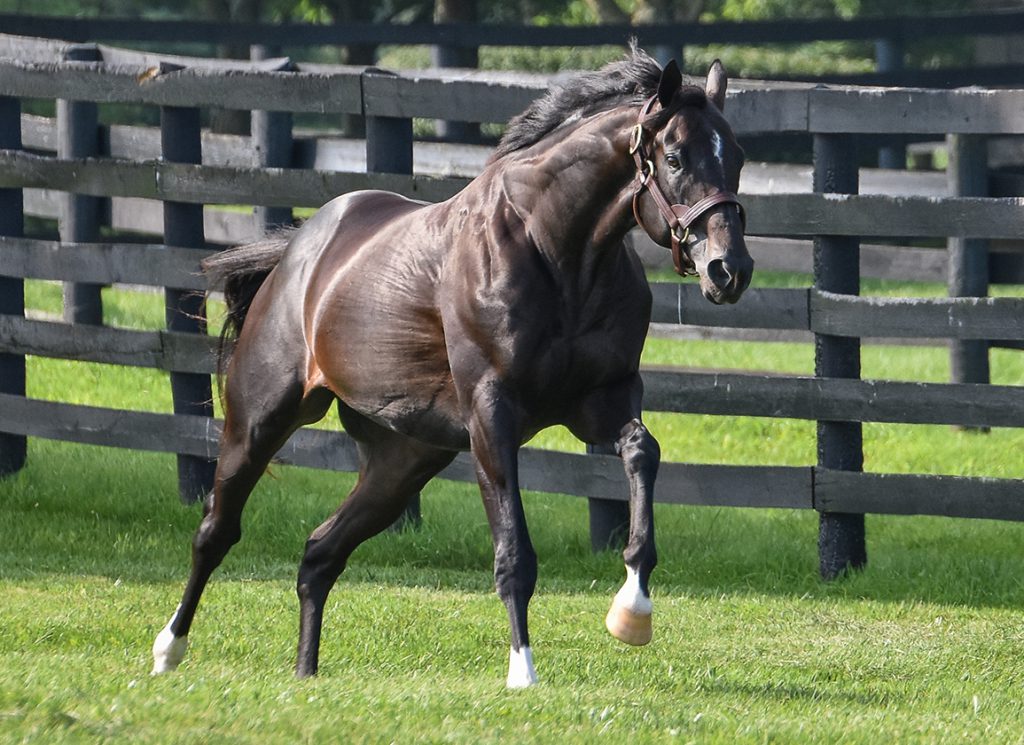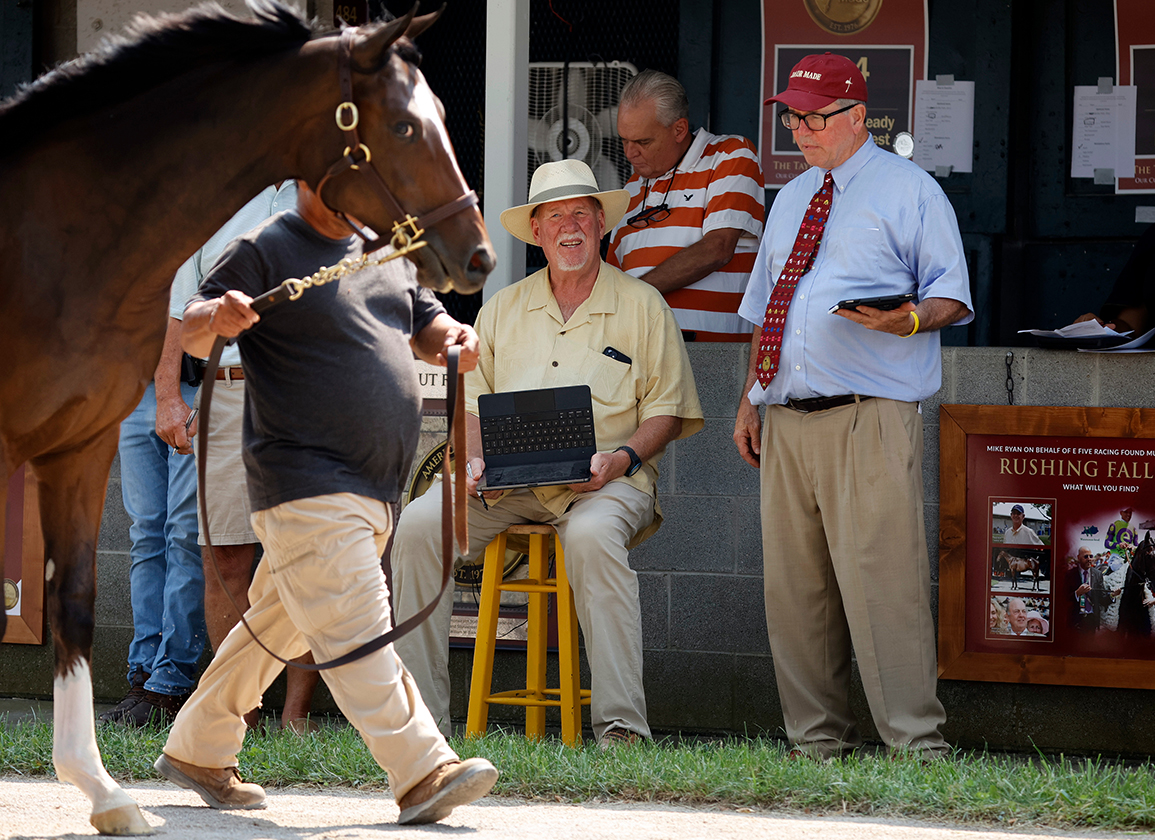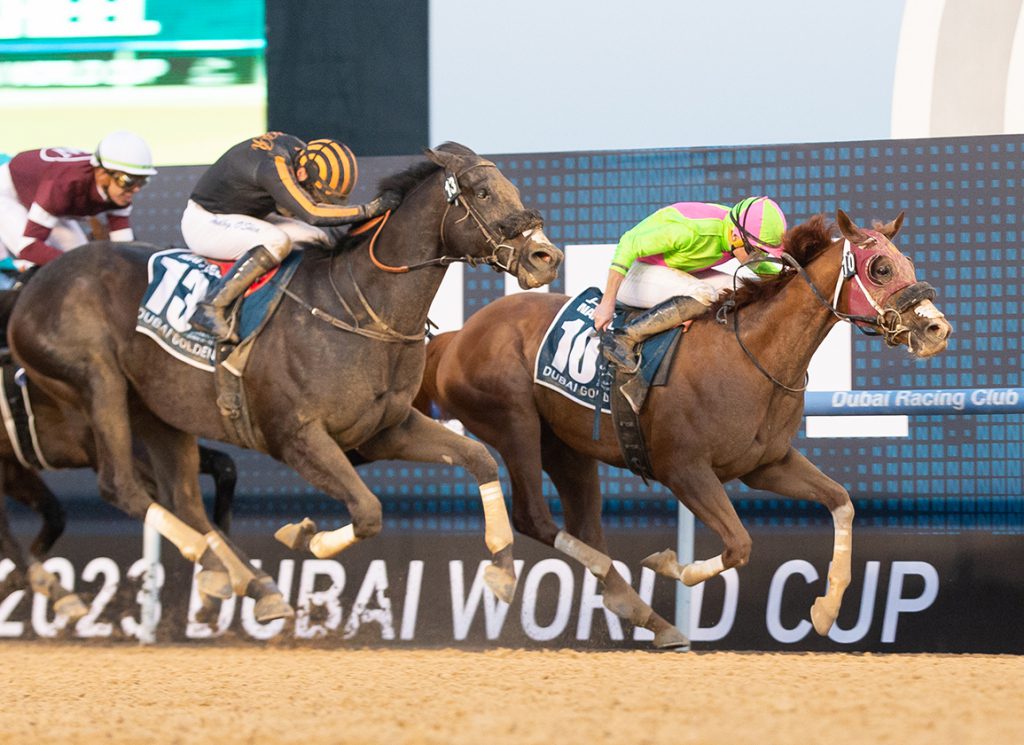By Chris McGrath
When Saint Ballado came to the farm, Duncan Taylor recalls Les Brinsfield telling him to try Mari's Book mares. “Mari's Book!” he exclaims now. “It's not like there were Mari's Book mares all around, out there in the population. But Les was a smart guy, very analytical.”
And it was easy to see the logic: Mari's Book was by Northern Dancer out of a Maribeau mare; and Maribeau, like Saint Ballado's sire Halo, was out of Cosmah–whose half-sister Natalma, of course, gave us the sire of Mari's Book. Plenty of genetic wheels within wheels there, then.
“So we bought this mare by Mari's Book, Goulash, [for Aaron Jones] and bred her to Saint Ballado four times,” Duncan resumes. “And we got like three stakes winners, one of them being Ashado. And it really made the stallion. But then Mr. McNair had a mare with very similar breeding, and I kept saying, 'You've got to breed her to Saint Ballado, got to!' So he did. And he got a swayback.” He chuckles. “Named it Duncan.”
Just one snapshot, this, of the breadth of experience that have given the Taylor brothers their plain-talking sense of how to make the best of a difficult game; and a wholesome, hard-headed scepticism about any theory or system purporting to make it easy.
And that, in turn, is why we've seized the pretext to visit two of them, Duncan and Mark, in a rather different capacity from the usual: to hear how the family ended up breeding an elite sprinter in Sibelius, winner of the G1 Golden Shaheen in Dubai.
Taylor Made is obviously far better known as the largest consignor in the business, and also for standing the likes of Not This Time, the sire of Sibelius. But anyone familiar with the energy and imagination they have always brought to their principal roles can only be curious to hear how they adapt their know-how to the kind of challenge that occupies the majority of their clients.
“Anytime you're big, you get exposed to more people, with more theories and more thoughts,” reasons Duncan, who formally handed over to Mark as President and CEO last year but remains a vital influence as Senior Consultant. “So you're able to soak those in, and get to talk about lots of different aspects. Where a guy that's out on his farm with his 15 broodmares, that's all he is focused on. He can read all the books, but–well, we're not even trying to hear stuff and we hear it.”
And that ties into a parallel conviction: that the best breeders, historically, have been able to weave many different strands of horsemanship together.
“I'm not knocking anyone else,” stresses Duncan. “But in my lifetime, just watching what's gone on, there's been two or three people that you just thought really knew what they were doing. John Nerud was one, Alec Head was another. There was a guy named Bob Bricken at Elmendorf that was a guru of breeding. And, like Tesio himself, what did they have in common? They basically had a 360-degree view of every horse. They knew how to train, knew how to raise horses. And they were around every single one, watching and looking and trying to figure out what worked best where.”
“Nobody is going to breed a terrible stall-walker to a terrible stall-walker,” agrees Mark. “Nerud, if he trained the sire and the dam, would know that this filly had a lot of talent but wasn't so good between the ears. So he'd need to give her something to balance that out. But a lot of these people doing matings on a computer, honestly they may never even have seen the mare or the stallion and they certainly have no idea about any of these other characteristics.”
And even when a Nerud or a Head noticed a recurring motif, they didn't make sweeping extrapolations.
“Say they see a Nodouble mare coming through this, this and this, and they could all run,” Duncan says. “Well, if I brought up a Nodouble mare that looked the exact opposite, they would know: 'Just because that S.O.B. is by Nodouble, it isn't the Nodouble that I want. I want one that looks like this one over here.'”
And seeing the bigger picture cuts through the whole program. “When you have control over the entire operation, you're not sending your horse to Trainer X,” Duncan says. “Because Trainer X is thinking, 'I could probably back off this horse and he would be okay later on, maybe win a stake or two. But he might be my only chance ever to win a Kentucky Derby. So I'm going to keep training hard on him.' And then he breaks down.
“Whereas if Nerud had him, he'd have said, 'Nope, we ain't running in the Derby. Back to the farm, and give him all he needs.' Because when that horse hits, it affects the value of eight others in his operation.”
The Taylors' own remarkable story, of course, attests to the fruitful combination of nature and nurture. Their father Joe literally wrote the book on farm management, having supervised Gainesway for 40 years; and any congenital flair for horses was further underpinned by the discipline and faith of their upbringing. And whatever they have in common, even this closest of clans are hardly cookie-cut, whether in aspect or outlook.
“Well, we had eight in our family,” muses Duncan. “And you can see a common look. But we're all different–and it's a 100% nick. It's the exact same with horses. The evolutionary scheme of genetics has so many variables.”
No guarantees, then, but nonetheless there are plainly rewards available if you put the work in. Another thing Duncan did when Saint Ballado arrived, for instance, was create a scoring system on every mare ever bred to his full-brother Devil's Bag.
“Let's say the ancestor was Buckpasser,” he explains. “Anytime Buckpasser was in the first six generations, I said, 'Okay, was it a stakes winner or not?' So if it was one-for-49, I know I don't like a lot of Buckpasser in there. And so on, for all the relatives. I had them in an alphabetical order and knew the rate that they hit at. And as Saint Ballado came through the ranks, we started keeping the same statistics. You're trying to see which ancestors are going to go with the horse, and sometimes you'd find others carried along the same way.”
But only sometimes.
“And what you find in this business is that most people want a simple answer,” he continues, in exasperated tones. “If there's 12 pies here, they want to be told that this one will taste best because it has half the ingredients my grandmother used, and she baked a hell of a pie. But the other half of the pie, we don't know what the damned ingredients are. And when I eat it, it doesn't taste like grandma's. But that pie brings more.”
“It's the microwave mentality, unfortunately,” Mark adds. “Whether it's accurate or not, they don't care, they just want something they can understand. So I get into fights all the time with people that just get fixated on one tool, which a lot of times will send you in totally the wrong direction. To me, if you look at what works on 'blood' then you find a lot of times it makes sense as a physical mating, from a conformation perspective.”
But we're forgetting why we troubled these gentlemen in the first place. And this Sibelius (targeting his first start since Dubai in the GII True North S. at Belmont on June 10) is a nice story, bringing together some of the most cherished stalwarts of this remarkable family firm.
He's out of Fiery Pulpit (Pulpit), an unraced half-sister to graded stakes winner Clamorosa (Seattle Dancer), acquired as a 7-year-old for $55,000 at the Keeneland November Sale of 2011. There's quite a gang involved: Pat Payne, who might almost be another brother; Jeff Hayslett, who's been working here for over 30 years; and two of the farm's oldest clients, in Louis Brooks and Sam Pollock.
“This mare is a good example of any breeding success that we've had,” Mark says. “Because most of the mares we own are in partnership with customers. We've never aspired to go out and say we're going to build some world-class broodmare band, become great breeders. It's more just coming alongside partners, who like to be commercial breeders. And in this mare's case, it was an interesting group. Pat was a partner of ours. Jeff was our farm manager and then our first Thoroughbred Advisor. The Pollocks have probably been with us 30 years, and the Brooks family maybe 40. The first yearling I ever took to the sales ring was a Secretariat filly [co-]bred by Louis.”
(That was the old July Sale at Keeneland in 1983: Wayne Lukas gave $525,000 for her and, as Fiesta Lady, she ended up a Grade I winner.)
Fiery Pulpit had managed to produce a minor stakes performer by Broken Vow, a son of Unbridled, so they tried her with Unbridled's Song. The result was a $400,000 Keeneland September colt who won seven times. Next came a colt by Graydar, this time a son of Unbridled's Song: Peter O'Callaghan bought him as a Keeneland November weanling for $185,000, and he became a hard-knocking, 11-for-48 campaigner. Then a colt by Will Take Charge made $250,000 at Keeneland September.
“Before we got ahold of her, her babies weren't bringing anything at all,” Mark notes. “But just by knocking on this Unbridled's Song thing, she became a slot machine, paying off every year.”
Typically, however, the one exception was her foal from the first crop of Not This Time–who has turned out to be her best runner. Offered as a short yearling at Keeneland January, he was a $62,000 RNA and it was a similar story after he had been moved on, returned at $75,000 in the same ring that September. Bottom line, however, is that Sibelius currently has a 19-7-3-3 record: pretty robust, for a horse that didn't vet.
“He was a beautiful horse,” Mark emphasizes. “Just sesamoiditis. We got him sold privately. It's like Duncan's just been saying about breeding theories. Vetting, X-rays, they're a tool, get you part of the way. But people want to be told that it's simple.”
That said, commercial breeders nowadays tend to think about the ring sooner than the racetrack–a reality in which Mark cheerfully acknowledges complicity.
“My winning post is making money,” he accepts. “The one thing I don't have the luxury of doing is breeding something that might come out ugly, and the market's going to reject it, but it might be a great racehorse. I can't afford to do that. I'm trying to breed a good-looking horse.”
Sadly it feels as though age may be catching up with Fiery Pulpit herself. She required colic surgery and, donated to one of the Taylor Made sales team who has a small farm, successfully conceived to Catalina Cruiser. After Sibelius won in Dubai, Mark called and said: “Hey did you see that? She just got a Grade I winner!” Unfortunately the reply was: “Didn't you get my text last night? She had a dystocia, the foal died.”
So much can go wrong, at any time. But just as people shouldn't pretend that the game is easy, nor should we make the simple things complicated. A lot of it is common sense.
“Basically, when we're breeding a mare, we're looking at the value and we're looking at the conformation,” Duncan says. “And not only the conformation of the two horses. If the mare's had foals before, you look at those too. Because she might not be toed-in herself, but three of the first four foals have been. So you're not going to breed to one that toes in.”
Maybe you'd have bred her to Unbridled, though, as he toed out somewhat. Duncan, indeed, remembers the team more or less having to beg people to support the horse pending his first runners.
“And then Unbridled's Song comes out of his first crop, and Grindstone,” he recalls. “Well, if Unbridled's Song had died foaling and Grindstone broke down before the Derby, maybe he'd have been in Turkey or something.”
The margins are always so fine. Duncan remembers deciding that Mutakddim mares might work with California Chrome, whose damsire was a half-brother to that horse's dam. That was a Mari's Book type of call. But sure enough, just about the best runner Chrome left behind was Cilla, whose second dam is by Mutakddim.
“Of course all the knockers of my theory can say, 'Cilla's out of an Into Mischief mare, you can breed anything to that horse,'” he admits. “But Mutakddim, I picked a random horse. Most of his horses are in South America. And he ends up in the pedigree of California Chrome's best horse. So there's something to it. But if you bred every Mutakddim mare to California Chrome, it still might only be three or four out of 100 foals. And then two of them, the trainers mess up, and another one gets loose on the track.”

Current Taylor Made stalwart Not This Time | Mary Ellet
Back we come, then, to the holistic approach. Because it's no good getting everything else right, and then having the whole thing unravel because you haven't matched the horse to the right trainer.
“If you want someone to coach a bunch of egomaniacs that all want to be the star, and turn them into the Bulls, you get in Phil Jackson,” Duncan reasons. “Somebody else is coaching them, it probably would never have happened. Same with trainers. The mating's one key factor. But you could have the smartest mating in the world, and you have a bad trainer or a bad foaling man, it's never going to come to fruition. So you need a team.”
He mentions one highly successful program. Could just be lucky, maybe, but he ticks off the quality of its land, farm management, sales scouts, trainers. “And if that gets a stallion from 10% stakes winners to 15%, that's a hell of a change in the economic value of that stallion,” he says. “Because he becomes the superior horse.”
Conversely, some stallions face adverse odds from the outset. At a given market level, they will only tend to get mediocre mares–and that won't just tell in the genes.
“Mortality and conception rates are hugely important to a stallion,” Mark says. “With lesser stallions, the conception rate tends to be just not as good because most of their mares come from farms that don't have the same resources or organization. So from the very beginning that stallion has more to overcome.”
“There's so many variables,” concludes Duncan. “But if that's a curse, it's also a blessing. Because if it was easy to do, these rich people wouldn't be intrigued as they are. They know it's hard, and that's just what keeps everybody interested.”
Not a subscriber? Click here to sign up for the daily PDF or alerts.











